The name of this pub recalls the inn which stood on the other side of High Street. Dating from at least the late 1700s, it was named after the cattle drovers who passed through Peckham on their way to Smithfield Market. The Kentish Drovers beer house dated from at least the late 1700s.
Framed prints and text about the Peckham Experiment.
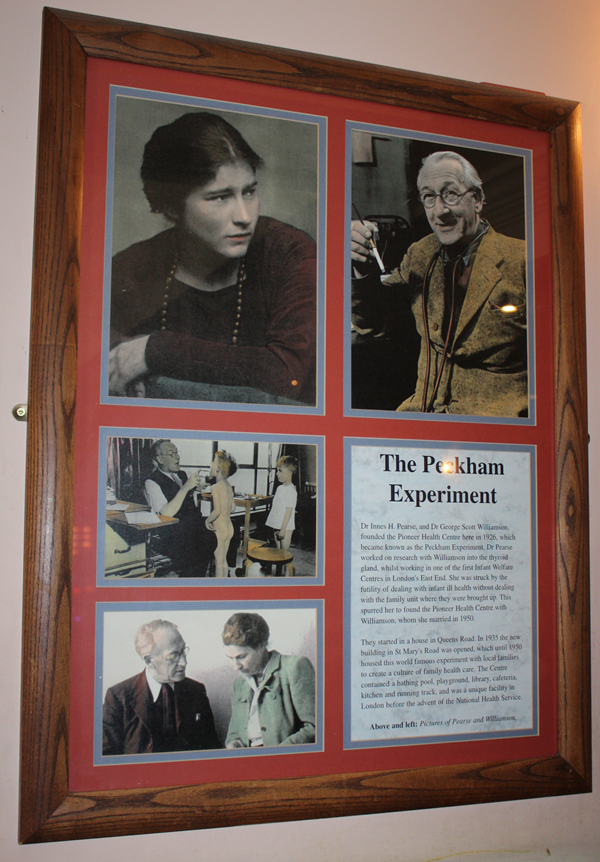
The text reads: Dr Innes H. Pearse, and Dr George Scott Williamson, founded the Pioneer Health Centre here in 1926, which became known as the Peckham Experiment. Dr Pearse worked on research with Williamson into the thyroid gland, whilst working in one of the first Infant Welfare Centres in London's East End. She was struck by the futility of dealing with infant ill health without dealing with the family unit where they were brought up. This spurred her to found the Pioneer Health Centre with Williamson, whom she married in 1950.
They started in a house in Queens Road. In 1935 the new building in St Mary’s Road was opened, which until 1950 housed this world famous experiment with local families to create a culture of family health care. The Centre contained a bathing pool, playground, library, cafeteria, kitchen and running track, and was a unique facility in London before the advent of the National Health Service.
Framed prints and text about Jones and Higgins.
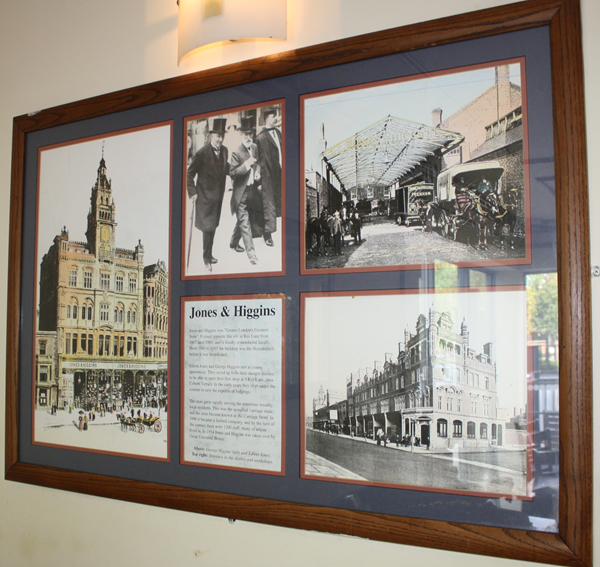
The text reads: Jones and Higgins was “Greater London’s Greatest Store”. It stood opposite this site in Rye Lane from 1867 until 1980, and is fondly remembered locally. From 1980 to 1985 the building was the Houndsditch, before it was demolished.
Edwin Jones and George Higgins met as young apprentices. They saved up from their meagre income to be able to open their first shop a 3 Rye Lane, then Coburn Terrace. In the early years they slept under the counter to save the expense of lodgings.
The store grew rapidly serving the numerous wealthy local residents. This was so-called ‘carriage trade’, and the store became known as the Carriage Store. In 1896 it became a limited company, and by the turn of the century there were 1200 staff, many of whom lived in. In 1954 Jones and Higgins was taken over by Great Universal Stores.
Above: George Higgins (left) and Edwin Jones
Top right: Entrance to the stables and workshops.
Framed prints, photographs and text about entertainment in Peckham.
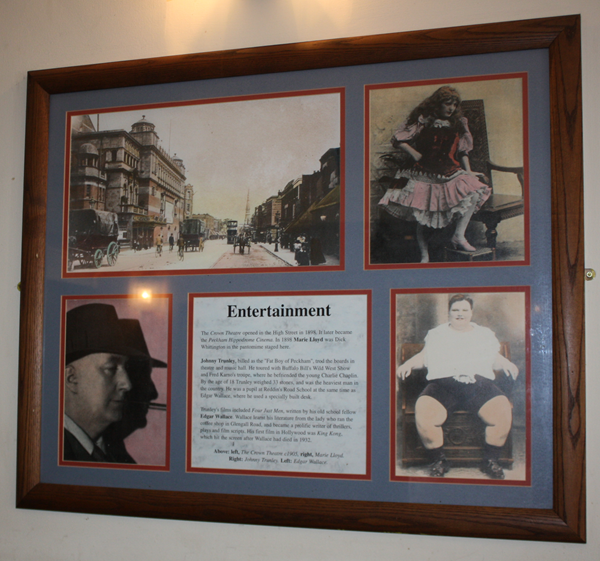
The text reads: The Crown Theatre opened in the High Street in 1898. It later became the Peckham Hippodrome Cinema. In 1898 Marie Lloyd was Dock Whittington in the pantomime staged here.
Johnny Trunley, billed as the “Fat Boy of Peckham”, trod the boards in theatre and music hall. He toured with Buffalo Bill’s Wild West Show and Fred Karno’s troupe, where he befriended the young Charlie Chaplin. By the age of 18 Trunley weighed 33 stones, and was the heaviest man in the country. He was a pupil at Reddin’s Road School at the same time as Edgar Wallace, where he used a specially built desk.
Trunley’s films included Four Just Men, written by his old school fellow Edgar Wallace. Wallace learnt his literature from the lady who ran the coffee shop in Glengall Road, and became a prolific writer of thriller, play and film scripts. His first film in Hollywood was King Kong, which hit the screen after Wallace had died in 1932.
Above: left, The Crown Theatre c1905, right, Marie Lloyd
Right: Johnny Trunley
Left: Edgar Wallace.
A framed print and text about Dr. Harold Moody.
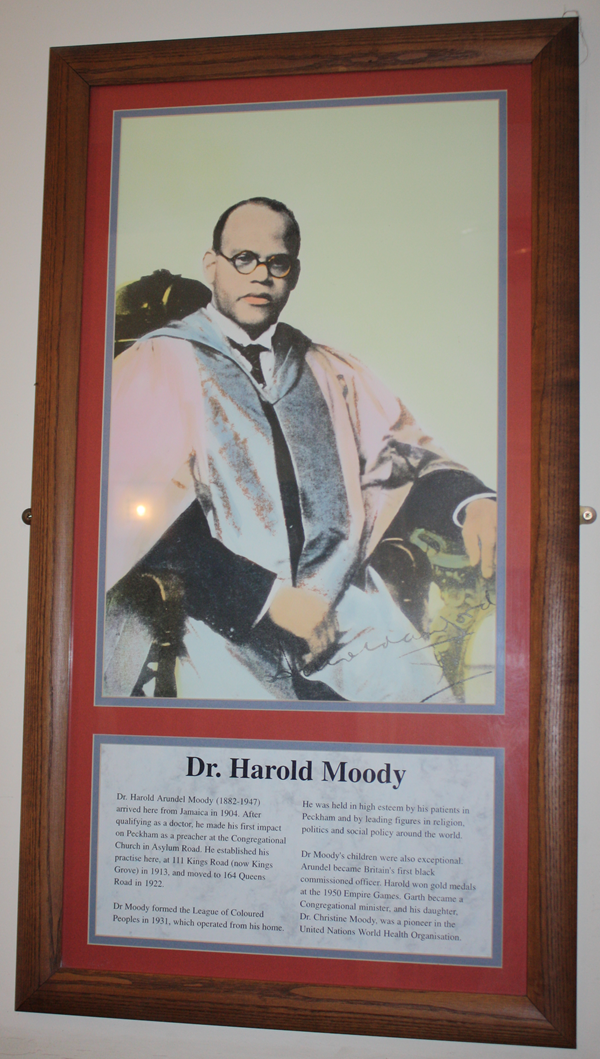
The text reads: Dr. Harold Arundel Moody (1882-1947) arrived here from Jamaica in 1904. After qualifying as a doctor, he made his first impact on Peckham as a preacher at the Congregational Church in Asylum Road. He established his practise here, at 111 Kings Road (now Kings Grove) in 1913, and moved to 164 Queens Road in 1922.
Dr Moody formed the League of Coloured Peoples in 1931, which operated from his home.
He was held in high esteem by his patients in Peckham and by leading figures in religion,
politics and social policy around the world.
Dr Moody's children were also exceptional. Arundel became Britain's first black commissioned officer. Harold won gold medals at the 1950 Empire Games. Garth became a Congregational minister, and his daughter, Dr. Christine Moody, was a pioneer in the United Nations World Health Organisation.
Framed prints and text about writing and writers of Peckham.
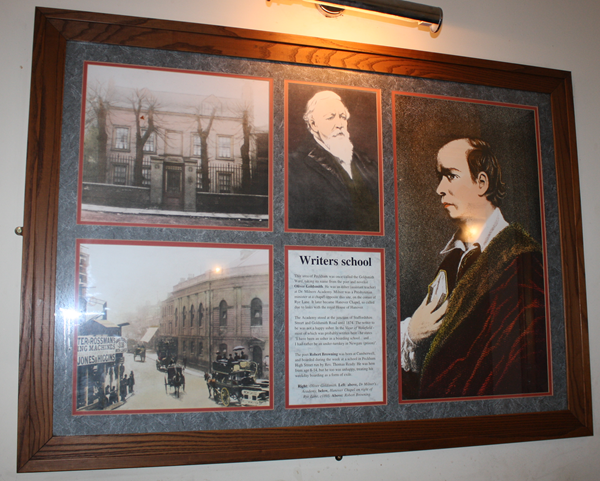
The text reads: This area of Peckham was once called the Goldsmith Ward, taking its name from the poet and novelist Oliver Goldsmith. He was an usher (assistant teacher) at Dr Milners Academy. Milner was a Presbyterian minister at a chapel opposite this site, on the corner of Rye Lane. It later became Hanover Chapel, so called due to links with the royal House of Hanover.
The Academy stood at the junction of Staffordshire Street and Goldsmith Road until 1874. The writer to be was not a happy usher. In the Vicar of Wakefield – most of which was probably written here – he states “I have been an usher in a boarding school… and… I had rather be an under-turnkey in Newgate (prison)”.
The poet Robert Browning was born at Camberwell, and boarded during the week at a school in Peckham High Street run by Rev. Thomas Ready. He was here from age 8-14, but he too was unhappy, treating his weekday boarding as a form of exile.
Right: Oliver Goldsmith
Left: above, Dr Milner’s Academy, below, Hanover Chapel on right of Rye Lane, c1895
Above: Robert Browning.
Framed prints and drawings about the early days of Peckham.
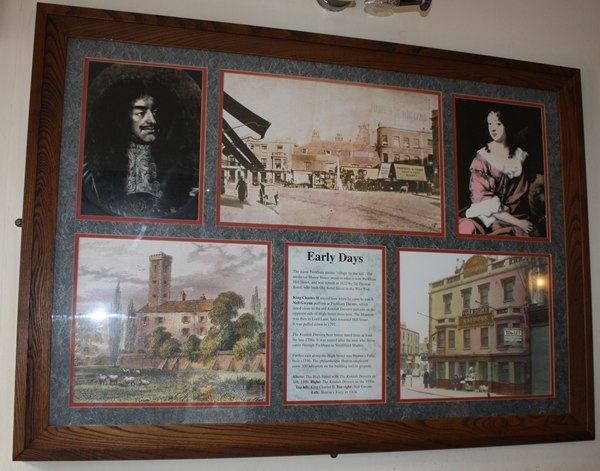
The text reads: The name Peckham means 'village by the hill'. The medieval Manor House stood in what is now Peckham Hill Street, and was rebuilt in 1672 by Sir Thomas
Bond, who built Old Bond Street in the West End.
King Charles II stayed here when he came to watch Nell Gwynn perform at Peckham Theatre, which stood close to the old Kentish Drovers pub site on the opposite side of High Street from here. The Mansion was then in Lord Lane, later renamed Hill Street. It was pulled down in 1797.
The Kentish Drovers beer house dated from at least the late 1700s. It was named after the men who drove cattle through Peckham to Smithfield Market.
Further cast along the High Street was Heaton’s Folly, built in c1750. The philanthropic Heaton employed some 500 labourers on the building and its grounds.
Above: The High Street with The Kentish Drovers on left, 1899
Right: The Kentish Drovers in the 1950s
Top left: King Charles II
Top right: Nell Gwynn
Left: Heaton’s Folly in 1804.
Framed photographs and text about the canal in Peckham.
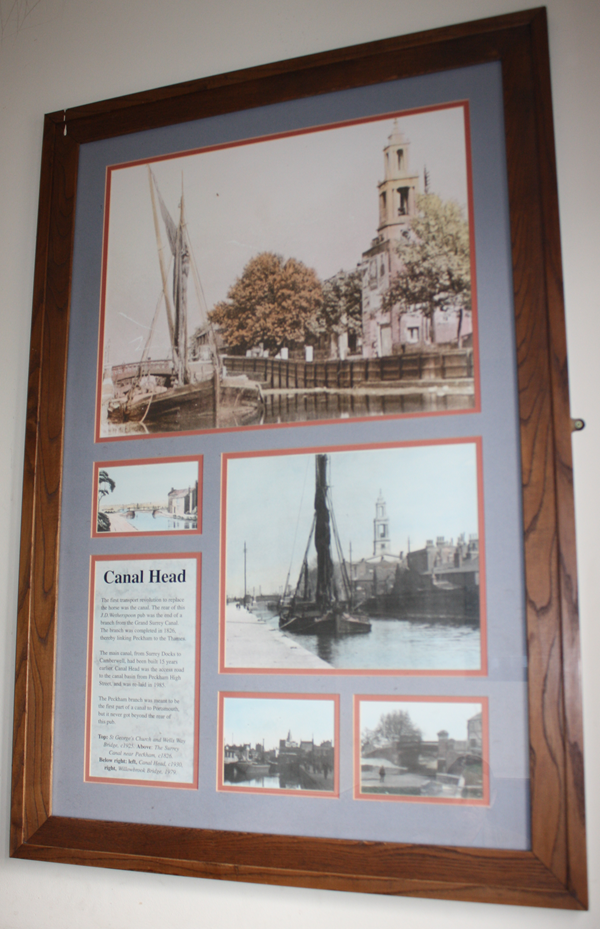
The text reads: The first transport revolution to replace the horse was the canal. The rear of this J.D.Wetherspoon pub was the end of a branch from the Grand Surrey Canal. The branch was completed in 1826, thereby linking Peckham to the Thames.
The main canal, from Surrey Docks to Camberwell, had been built 15 years earlier. Canal Head was the access road to the canal basin from Peckham High Street, and was re-laid in 1985.
The Peckham branch was meant to be the first part of a canal to Portsmouth, but it never got beyond the rear of this pub.
Top: St George’s Church and Wells Way Bridge, c1925
Above: The Surrey Canal near Peckham, c1826
Below right: left, Canal Head, c1930, right, Willowbrook Bridge, 1979.
A framed photograph of High Street, Peckham, c.1910.
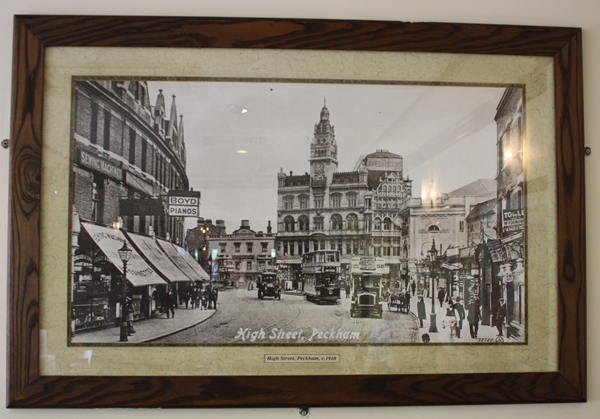
A framed photograph of High Street, Peckham, c.1910.
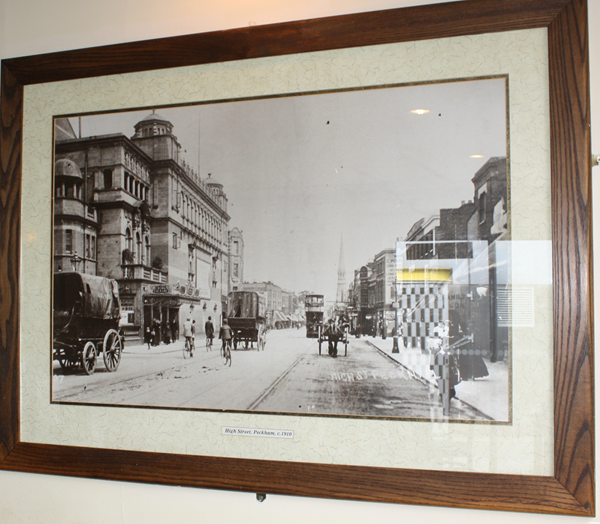
External photograph of the building – main entrance.
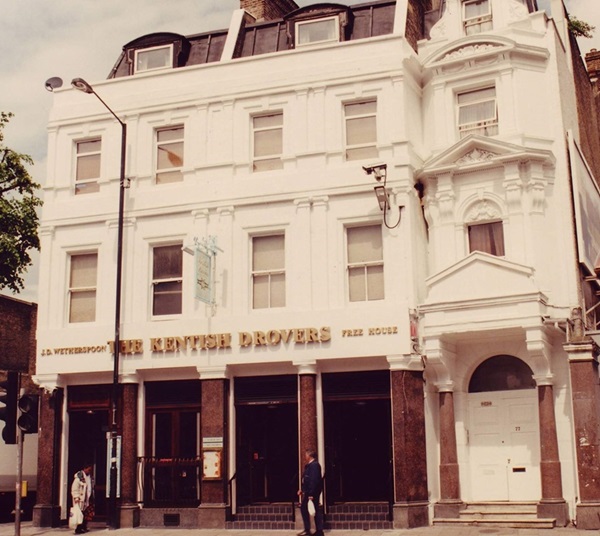
If you have information on the history of this pub, then we’d like you to share it with us. Please e-mail all information to: pubhistories@jdwetherspoon.co.uk